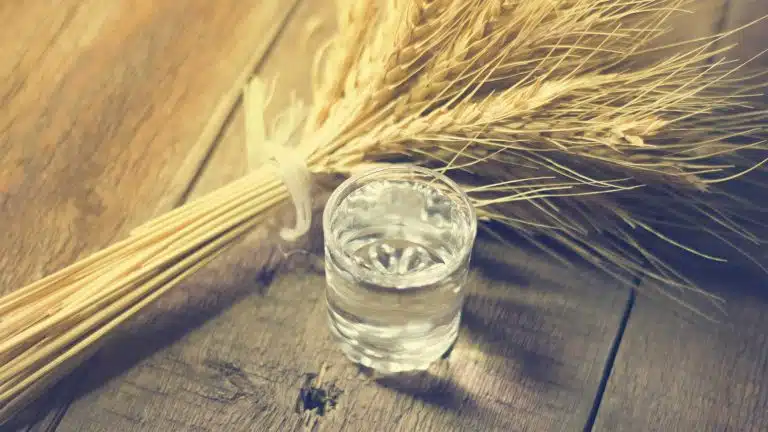How Vodka Is Made | Ingredients & Production

Few alcoholic beverages have quite the range or reputation of vodka. This clear and internationally popular spirit has a high alcohol content and was originally produced as early as the 8th or 9th century in Poland or Russia.
To this day vodka is the national drink in both nations. Its production is heavily regulated to ensure that all Russian and Polish vodka is produced using the proper method with the right ingredients.
In the U.S., however, the definition and production of vodka is far more flexible and varied.
Ingredients In Vodka
Vodka can and has been made with almost any base ingredient that can ferment. In other words, anything containing the proper quantity of sugars and/or starches.
This has included:
- grapes
- wheat
- rye
- potatoes
- sorghum
- fruit
- corn
- rice
- molasses
- table sugar
Most modern, commercially available vodka is made with either wheat, rye, potato, or a mix of grains. Depending on which base ingredients are used, the overall flavor and feel of the vodka will change, with experts advising that mixed grains be avoided for a high-quality beverage.
Vodka production also requires distilled water, yeast, and (depending on the base) food-grade amylase enzyme powder to break down the starches in your base ingredient into sugar, which can then be used in the fermentation process.
How To Make Vodka
From simple potato vodka to top-shelf bottles, distilleries use the same general process when producing vodka.
Step 1: Prepare A Mash
Mash is a mixture of shredded raw ingredients and water that gets heated to around 150° F (66° C) and mixed together with the appropriate enzymes.
These enzymes require a very specific temperature range to work and can be destroyed if the temperature of the potato mash climbs too high.
When using crushed malted barley, rye, or wheat, it isn’t necessary to add enzymes—these grains already process natural enzymes and will readily break down into fermentable sugar. These bases will still need to be prepared and mashed before fermentation, however.
Enzymes are also not required if you’re using a base that is high in sugars already, such as refined table sugar or molasses, and these bases do not require mashing.
A mash is typically heated for around two hours and then allowed to cool until it is noticeably warm, rather than hot.
Step 2: Fermenting The Mash
Once the mash is ready it is strained through a cheesecloth or filtered through some other means, extracting the liquid and sugars from the solid pulp.
Next, a type of yeast is added to this strained mash to convert the sugars into ethanol (alcohol) and carbon dioxide (a gas that is released by the fermentation process).
It’s important that the fermentation and distillation processes be conducted in sanitized and sterile containers with an airlock to allow carbon dioxide out without allowing either oxygen or foreign bacteria in.
Otherwise, the final result may be contaminated by unwanted byproducts, changing and often ruining the flavor profile.
This process lasts for between three and five days.
Step 3: Collection & Filtration
As the yeast finishes fermentation it will collect as sediment on the bottom of the fermentation vessel. The clear, alcoholic liquid above, called the wash, is transferred into a sterilized container using a siphon and is sometimes filtered to increase purity.
Step 4: Distillation
Using either a column still, pot still, or reflux still, the wash (which has a relatively low ABV like a beer or hard cider) is heated such that the alcohol boils but the water does not.
This alcohol rises as a vapor and is then converted back into a liquid by a condenser, collecting in a separate container.
The first few ounces of distillate that are collected must be discarded, as this “head” will contain harmful methanol and other unwanted, volatile chemical byproducts. Likewise, the “tails” produced late in the process will need to be discarded due to the presence of fusel alcohols.
The alcohol can then be distilled or filtered further before being diluted, bottled, and consumed.
Legal Issues & Distilling Homemade Vodka
Distilling your own vodka, rum, gin, or other homebrew moonshine is illegal in the United States unless prospective distillers obtain a distilled spirits permit.
Fuel alcohol permits are free and widely available but stipulate that the individual registering will distill alcohol solely for the purpose of fuel rather than human consumption.
Also, be aware that many states and local governments set further limits on amateur or at-home distillation.
To learn about our alcohol treatment programs, please contact us today.
Vodka FAQs
How Much Alcohol Is In Vodka?
Most vodka has a 40% ABV, or alcohol by volume. If 10 ounces of standard vodka were served to you, 4 of those ounces would be pure alcohol. Some vodka products are stronger than 40% ABV, and some recipes for mixed drinks call for vodka to be mixed with other types of alcohol.
Learn more about Vodka Alcohol Content
What Does Vodka Taste Like?
Vodka is usually tasteless, but it can also burn with a bitter aftertaste if you drink it. Mixing vodka with other ingredients, or picking out high-quality vodka at the store, can help you avoid the burning feeling.
To learn more, read What Does Vodka Taste Like?
How Many Shots Of Vodka Does It Take To Get Drunk?
In general, women can get drunk on vodka after three or four 1.5 fluid ounce shots, while men can get drunk on vodka after five or six shots of vodka.
However, differences in body weight, age, tolerance, and whether you’re drinking on a full or empty stomach can greatly influence the effect and risk of any alcoholic beverage.
Learn more about Drinking Vodka To Get Drunk
Why Do Some People Drink Vodka Straight?
People may prefer drinking vodka straight to avoid extra calories, to get drunk faster, or to feel more accomplished about their drinking habits. Drinking vodka straight can lead to higher impairment, a higher risk of blackouts, and long-term health problems.
Learn more about Drinking Vodka Straight
What’s The Difference Between Vodka & Whiskey?
Vodka and whiskey differ in color, taste, how they’re served, and how they are made.
Learn more about Vodka Vs. Whiskey
How Much Is A Fifth Of Vodka?
Traditionally, a fifth of vodka referred to one-fifth of a gallon of vodka, which equals 25.6 US fluid ounces or 757 milliliters. Today, though, the term refers to a 750 milliliter bottle of vodka.
The price of a fifth of vodka varies among brands. For example, a fifth of Smirnoff Vodka usually costs between $9.47 and $15.99, while a fifth of Grey Goose Vodka costs between $30 and $99.99.
Learn more about Vodka Prices
Do Some People Actually Soak Tampons In Vodka?
It is possible to soak tampons in vodka and insert them into the rectum or vagina. Due to the countless health hazards, including severe alcohol poisoning, this practice does not occur frequently.
This is an extreme form of alcohol abuse and those who are involved in this practice should quit immediately before developing skin damage and other health issues.
Learn more about Vodka-Soaked Tampons
Is Vodka Good For You?
Vodka has been studied for its use as a disinfectant, pain reliever, and to reduce the risk of certain diseases. In moderation, vodka may reduce the risk of certain types of cardiovascular disease, including stroke and heart attack.
In some people, however, the benefits may not outweigh the risks. Heavy drinking can increase the risk of heart disease, liver disease, and cancer. People who drink heavily may also be at a higher risk of developing alcoholism.
To learn more, read Is Vodka Good For You?
What’s The Difference Between Vodka & Gin?
The differences between vodka and gin include what they’re made out of, their taste, and how they’re served.
What’s The Difference Between Vodka & Rum?
Vodka and rum are both distilled spirits. However, vodka originates in Poland and Russia while rum originates in the Caribbean.
Vodka is made by using wheat and grains while rum uses sugarcane juice. In addition, rum can be divided into several categories that give you options of flavor, appearance, and taste.
Learn more about Vodka Vs. Rum
What’s The World’s Strongest Vodka?
The world’s strongest vodka is Spirytus Rektyfikowany (96% ABV and 192 proof).
Learn more about the Strongest Vodkas In The World
What Is A Handle Of Vodka?
A handle of vodka is a large bottle of alcohol that consists of 1.75 liters of liquor. This is the equivalent of 59.2 fluid ounces. A 1.75 liter bottle of liquor is the largest format in which hard liquor is sold.
To learn more, read How Many Drinks In A Handle Of Vodka
What’s The Difference Between Vodka & Tequila?
Vodka and tequila differ in taste, ingredients, and where they come from.
Learn more about Vodka Vs Tequila
Is It Okay To Drink Vodka Every Day?
Even if you can keep your drinking levels low, drinking vodka every day can still cause health effects like tolerance and liver problems. If you cannot control your drinking habits, drinking vodka every day can be dangerous to your health.
Learn more about Drinking Vodka Every Day
Written by Ark Behavioral Health Editorial Team
©2024 Ark National Holdings, LLC. | All Rights Reserved.
This page does not provide medical advice.
Britannica - How vodka is made explained
Food and Drug Administration (FDA) - Distilled Spirits

Questions About Treatment?
Ark Behavioral Health offers 100% confidential substance abuse assessment and treatment placement tailored to your individual needs. Achieve long-term recovery.
100% confidential. We respect your privacy.
Prefer Texting?
Our friendly support team is here to chat 24/7. Opt out any time.







 Learn More
Learn More








